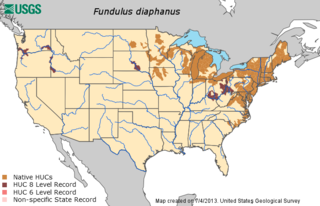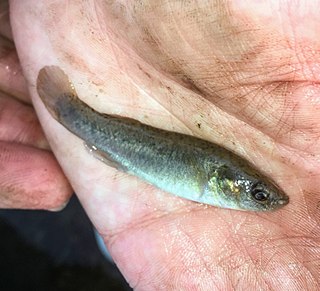
Cyprinodontiformes is an order of ray-finned fish, comprising mostly small, freshwater fish. Many popular aquarium fish, such as killifish and live-bearers, are included. They are closely related to the Atheriniformes and are occasionally included with them. A colloquial term for the order as a whole is toothcarps, though they are not actually close relatives of the true carps – the latter belong to the superorder Ostariophysi, while the toothcarps are Acanthopterygii.

The mummichog is a small killifish found along the Atlantic coast of the United States and Canada. Also known as Atlantic killifish, mummies, gudgeons, and mud minnows, these fish inhabit brackish and coastal waters including estuaries and salt marshes. The species is noted for its hardiness and ability to tolerate highly variable salinity, temperature fluctuations from 6 to 35 °C, very low oxygen levels, and heavily polluted ecosystems. As a result, the mummichog is a popular research subject in embryological, physiological, and toxicological studies. It is also the first fish ever sent to space, aboard Skylab in 1973.

Fundulus is a genus of ray-finned fishes in the superfamily Funduloidea, family Fundulidae. It belongs to the order of toothcarps (Cyprinodontiformes), and therein the large suborder Cyprinodontoidei. Most of its closest living relatives are egg-laying, with the notable exception of the splitfin livebearers (Goodeidae).

Fundulidae is the family of topminnows and North American killifishes.

The California killifish is a type of killifish (Fundulidae) found along the coast of southern California and Baja California.

The sheepshead minnow, also known as sheepshead pupfish, is a species of ray-finned fish in the family Cyprinodontidae, the pupfishes. It is found in salt marsh and estuary environments and is native to the eastern coasts of North and Central America.

The banded killifish is a North American species of temperate freshwater killifish belonging to the genus Fundulus of the family Fundulidae. Its natural geographic range extends from Newfoundland to South Carolina, and west to Minnesota, including the Great Lakes drainages. This species is the only freshwater killifish found in the northeastern United States. While it is primarily a freshwater species, it can occasionally be found in brackish water.

The saltmarsh topminnow is a species of killifish for the family Fundulidae. It occurs in the costal wetlands of the Gulf of Mexico in the United States.
The Bermuda killifish is a small fish which is endemic to the islands of Bermuda in the western Atlantic Ocean. It belongs to the genus Fundulus in the killifish and topminnow family, Fundulidae.

The rainwater killifish is a small silvery fish with yellow flashes and diamond shaped scales that is widespread from Cape Cod, Massachusetts, through to Tampico, Mexico. It is commonly found in large numbers in fresh to brackish estuarine environments. It feeds on tiny crustaceans, mosquito larvae, small worms, and mollusks. It can reach up to 62 mm.

The golden topminnow is a fish of the genus Fundulus and is a United States native fish mostly distributed throughout the southeast, ranging from Kentucky and Ohio south into Florida. Although it has such a wide distribution throughout the south, the habitats and micro-habitats that it occupies do not differ much from one area of distribution to others. The golden topminnow is a small surface feeding fish that tends to reproduce late in the spring season and on into the early parts of the summer, and although the fry reach maturity fairly quickly the longevity of the golden topminnow is quite short. Because the golden topminnow is lower in the trophic level and is a small fish, it primarily feeds on small and/or drifting organisms at, or near the surface of, vegetated areas. This particular topminnow is not currently listed as an endangered species, nor does it have any particular type of management plan.
The blackspotted topminnow, Fundulus olivaceus, is a species of fish in the family Fundulidae: the topminnows and North American killifishes. It is native to the south-central United States, where it is known from the drainages of the Mississippi River from Illinois to the Gulf of Mexico and as far west as Galveston Bay.

The southern studfish is a ray-finned fish of the family Fundulidae, the tooth carps, that is native to the southeastern United States.

The plains topminnow is a species of freshwater topminnow found in North America. The fish has a small range within the United States of America which consists of two major populations.
The diamond killifish is a species of North American killifish found in salt marshes, hypersaline flats and mangrove along the Gulf Coast of the United States. This species grows to a length of 6 cm (2.4 in). It is found in the aquarium trade. It was previously recognized as, Adinia xenica, the only known member of its genus. Nucleotide analyses has reevaluated the phylogeny of the Funduliidae and placed the diamond killifish into the Fundulus genus.

The Gulf killifish is one of the largest members of the genus Fundulus; it is capable of growing up to 7 inches (18 cm) in length, whereas the majority of other Fundulus reach a maximum length of 4 inches (10 cm). Therefore, F. grandis is among the largest minnows preyed upon by many sport fish, such as flounder, speckled trout, and red drum. Fundulus derives from the Latin meaning "bottom," and grandis means "large". The Gulf killifish is native to the Gulf of Mexico from Texas to Florida and the eastern coast of Florida and the Caribbean Sea in the Atlantic Ocean. Threats to the survival of the Gulf killifish include extreme changes in salinity, changes in temperatures, and toxic events such as the hypoxic dead zone in Louisiana and the Deepwater Horizon oil spill. The Gulf killifish is currently being used to test the effects of oil and oil dispersants on the physiology of marine species affected by these substances. This is significant to conservation biology, because with the continued extraction of oil and other natural resources from North American waters, it has become increasingly important to understand the risks and consequences in worst-case scenarios, such as the Deepwater Horizon oil spill, and the lasting effects on the marine ecosystem.

Aphanius danfordii, the Kızılırmak toothcarp or Sultan Sazlığı toothcarp, is a species of killifish belonging to the family Cyprinodontidae. It is endemic to the Kızılırmak River and the upper Seyhan River drainage systems and is now restricted to a few locations in the Sultan Sazlığı marshes. Though little data is available, the population of the fish seems to be declining. The International Union for Conservation of Nature has rated its conservation status as being "critically endangered" and fears it may become extinct in the wild if the drainage of the marshes continues.

The bayou killifish or bayou topminnow is a topminnow-like fish that thrives primarily in the shallow waters off the shores of the Americas, as well as fresh and brackish waters. Feeding off of small vertebrates and invertebrates, this fish displays reproduction techniques unique to its species.

Fundulus nottii, the bayou topminnow or southern starhead topminnow, is a fish of the family Fundulidae [1] found in the southeastern United States.

The Seminole killifish is a fish of the genus Fundulus, endemic to the U.S. state of Florida.

















